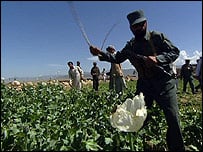Heroin is "Good for Your Health": Occupation Forces support Afghan Narcotics Trade
Multibillion dollar earnings for organized crime and Western financial Institutions by Prof. Michel Chossudovsky | |
Global Research, April 29, 2007 | |
The occupation forces in Afghanistan are supporting the drug trade, which brings between 120 and 194 billion dollars of revenues to organized crime, intelligence agencies and Western financial institutions. "Respected people of Helmand. The soldiers of ISAF and ANA do not destroy poppy fields," it said. "They know that many people of Afghanistan have no choice but to grow poppy. ISAF and the ANA do not want to stop people from earning their livelihoods." ( Quoted in The Guardian, 27 April 2007)
While the controversial opium ads have been casually dismissed as an unfortunate mistake, there are indications that the opium economy is being promoted at the political level (including the British government of Tony Blair). The Western media in chorus blame the Taliban and the warlords. Western officials are said to believe that "the trade is controlled by 25 smugglers including three government ministers." (Guardian, op. cit). Yet in a bitter irony, US military presence has served to restore rather than eradicate the drug trade. Opium production has increased 33 fold from 185 tons in 2001 under the Taliban to 6100 tons in 2006. Cultivated areas have increased 21 fold since the 2001 US-led invasion. What the media reports fail to acknowledge is that the Taliban government was instrumental in 2000-2001 in implementing a successful drug eradication program, with the support and collaboration of the UN. Implemented in 2000-2001, the Taliban's drug eradication program led to a 94 percent decline in opium cultivation. In 2001, according to UN figures, opium production had fallen to 185 tons. Immediately following the October 2001 US led invasion, production increased dramatically, regaining its historical levels. The Vienna based UN Office on Drugs and Crime estimates that the 2006 harvest will be of the order of 6,100 tonnes, 33 times its production levels in 2001 under the Taliban government (3200 % increase in 5 years). Cultivation in 2006 reached a record 165,000 hectares compared with 104,000 in 2005 and 7,606 in 2001 under the Taliban According to the UN, Afghanistan supplies in 2006 some 92 percent of the world's supply of opium, which is used to make heroin. The UN estimates that for 2006, the contribution of the drug trade to the Afghan economy is of the order of 2.7 billion. What it fails to mention is the fact that more than 95 percent of the revenues generated by this lucrative contraband accrues to business syndicates, organized crime and banking and financial institutions. A very small percentage accrues to farmers and traders in the producing country. (See also UNODC, The Opium Economy in Afghanistan,
Based on wholesale and retail prices in Western markets, the earnings generated by the Afghan drug trade are colossal. In July 2006, street prices in Britain for heroin were of the order of Pound Sterling 54, or $102 a gram. Narcotics On the Streets of Western Europe One kilo of opium produces approximately 100 grams of (pure) heroin. 6100 tons of opium allows the production of 1220 tons of heroin with a 50 percent purity ratio. The average purity of retailed heroin can vary. It is on average 36%. In Britain, the purity is rarely in excess of 50 percent, while in the US it can be of the order of 50-60 percent. Based on the structure of British retail prices for heroin, the total proceeds of the Afghan heroin trade would be of the order of 124.4 billion dollars, assuming a 50 percent purity ratio. Assuming an average purity ratio of 36 percent and the average British price, the cash value of Afghan heroin sales would be of the order of 194.4 billion dollars. While these figures do not constitute precise estimates, they nonetheless convey the sheer magnitude of this multibillion dollar narcotics trade out of Afghanistan. Based on the first figure which provides a conservative estimate, the cash value of these sales, once they reach Western retail markets are in excess of 120 billion dollars a year. (See also our detailed estimates for 2003 in The Spoils of War: Afghanistan's Multibillion Dollar Heroin Trade, by Michel Chossudovsky, The UNODC estimates the average retail price of heroin for 2004 to be of the order of $157 per gram, based on the average purity ratio). Narcotics: Second to Oil and the Arms Trade The foregoing estimates are consistent with the UN's assessment concerning the size and magnitude of the global drug trade. The Afghan trade in opiates (92 percent of total World production of opiates) constitutes a large share of the worldwide annual turnover of narcotics, which was estimated by the United Nations to be of the order of $400-500 billion. (Douglas Keh, Drug Money in a Changing World, Technical document No. 4, 1998, Vienna UNDCP, p. 4. See also United Nations Drug Control Program, Report of the International Narcotics Control Board for 1999, E/INCB/1999/1 United Nations, Vienna 1999, p. 49-51, and Richard Lapper, UN Fears Growth of Heroin Trade, Financial Times, 24 February 2000). Based on 2003 figures, drug trafficking constitutes "the third biggest global commodity in cash terms after oil and the arms trade." (The Independent, 29 February 2004). Afghanistan and Colombia (together with Bolivia and Peru) consitute the largest drug producing economies in the world, which feed a flourishing criminal economy. These countries are heavily militarized. The drug trade is protected. Amply documented the CIA has played a central role in the development of both the Latin American and Asian drug triangles. The IMF estimated global money laundering to be between 590 billion and 1.5 trillion dollars a year, representing 2-5 percent of global GDP. (Asian Banker, 15 August 2003). | |



0 Comments:
Post a Comment
<< Home